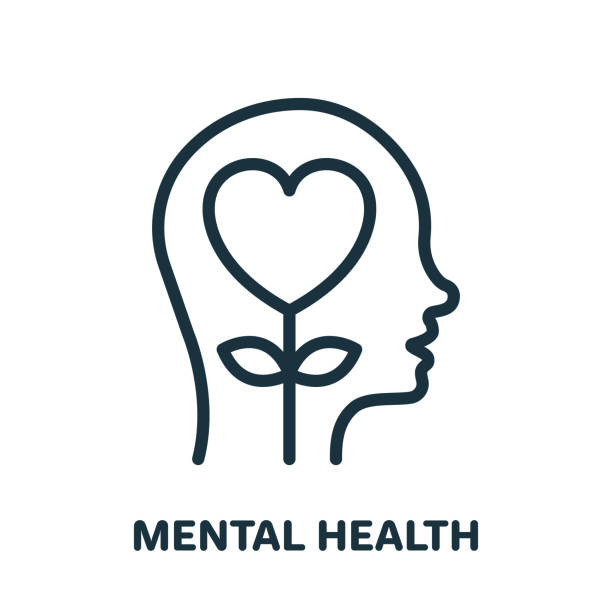here is the informataion about 8 Signs of Good Mental Wellbeing In today’s fast-paced world, mental health is more important than ever. It’s the foundation of a happy and fulfilled life, influencing everything from our relationships to our work performance. But what exactly constitutes good mental well-being? How can we recognize it in ourselves and others? This article will explore ten clear signs that indicate a person is experiencing good mental health. Understanding these signs can help us strive for a healthier mind and a more balanced life.
Table of Contents
ToggleDefinition of Mental Wellbeing with 8 Signs of Good Mental Wellbeing
Mental health refers to the state in which a person can cope with the normal stresses of life, work productively, and contribute to his or her community. It is a state of overall mental health, not just the absence of mental illness.
The terms “mental well-being” and “mental health” are often used interchangeably, but they refer to different concepts. Here is a detailed difference between the two:
Mental health
Definition:
Mental health refers to a person’s state of psychological and emotional functioning. It includes the presence or absence of mental disorders and the overall ability to manage stress, maintain relationships and function in daily life.
Key Features
1. Clinical Focus: Includes diagnosis and treatment of mental disorders such as depression, anxiety, schizophrenia, and bipolar disorder.
2. Symptoms and Conditions: Addresses specific symptoms and conditions that may affect one’s ability to work.
3. Therapeutic Perspective: Often involves medical or therapeutic interventions such as psychotherapy, medication, or counseling.
4. Prevention and Management: Focuses on preventing mental disorders, early intervention, and management of ongoing conditions.
Indicators:
– Presence or absence of mental illness.
– Ability to withstand normal stress.
– Ability to work productively and productively.
– Maintaining complete relationships.
Mental health
Definition:
Mental health refers to a broader concept that includes overall happiness, life satisfaction, and a sense of purpose. It is about how people feel about their lives and themselves, and covers both emotional and psychological dimensions.
Key Features:
1. Positive Focus: Emphasizes the positive aspects of life, such as happiness, contentment and a sense of purpose.
2. Holistic Approach: Considers a wide range of factors including emotional, social, and spiritual well-being.
3. Quality of Life: Looks at overall quality of life and life satisfaction beyond the absence of mental illness.
4. Growth and Fulfillment: Includes personal growth, fulfillment, and achieving one’s potential.
Indicators:
– Level of life satisfaction and happiness.
– A sense of purpose and meaning in life.
– Ability to form and maintain healthy relationships.
– Engaging in meaningful and enjoyable activities.
Interconnection
While mental health and mental well-being are distinct, they are interrelated:
– Effects on each other: Good mental health can contribute to good mental health and vice versa. For example, effectively managing a mental health condition can improve a person’s overall sense of well-being.
– Comprehensive approach: Addressing mental health problems often requires consideration of mental health, as overall life satisfaction and emotional health can influence recovery and management.
– Integrated care: An integrated approach to mental health care includes not only the treatment of mental illness, but also the promotion of mental health.
Summary
– Mental Health: Focuses on the diagnosis, treatment and management of mental disorders and psychological conditions.
– Mental Well-Being: Includes a broader, more holistic view of a person’s overall happiness, life satisfaction, and emotional health.
Understanding the difference between these two concepts helps to promote a more comprehensive approach to both prevention and care, ensuring that individuals achieve both sickness absence and a positive state of well-being.
10 Signs of Good Mental Wellbeing
Sign 1: Positive Self-Perception
Positive self-perception
Definition:
Positive self-concept refers to one’s ability to view oneself in a positive light, recognizing one’s abilities, talents, and abilities. It involves a realistic but positive understanding of one’s characteristics, abilities and potential.
Features:
1. Confidence:
– Confidence in your ability to complete tasks and face challenges.
– Feel confident about your decisions and actions.
2. Self Esteem:
– Feel worthy of your appreciation and happiness and success.
– Maintaining a healthy level of self-esteem and self-worth.
3. Self-admission:
– Embrace all aspects of yourself, including imperfections and past mistakes.
– Feeling satisfied with who you are, without undue self-criticism.
4. Identification of Shakti:
– Recognizing and acknowledging individual talents, skills, and achievements.
– Focus on positive qualities instead of focusing on weaknesses.
5. Optimism:
– Having an optimistic and positive outlook on life and future possibilities.
– Believing
Sign 2: Healthy Relationships
Healthy Relationships
Definition
Healthy relationships are characterized by mutual respect, trust, open communication, and a sense of connection and support between individuals. These relationships contribute positively to one’s mental and emotional wellbeing.
Characteristics:
1. Mutual Respect:
– Valuing each other’s opinions, feelings, and boundaries.
– Treating each other with kindness and consideration.
2. Trust:
– Feeling confident in the reliability and integrity of the other person.
– Trusting that the other person has your best interests at heart.
3. Open Communication:
– Expressing thoughts and feelings honestly and openly.
– Listening actively and empathetically to each other.
4. Support:
– Offering emotional and practical support in times of need.
– Encouraging each other’s personal growth and wellbeing.
5. Equality:
– Maintaining a balanced and fair dynamic in the relationship.
– Sharing responsibilities and decision-making equally.
Benefits:
– Enhanced Wellbeing: Healthy relationships can reduce stress and increase happiness, contributing to overall mental and emotional health.
– Personal Growth: They provide a safe space for personal development and self-improvement.
– Conflict Resolution: Healthy relationships equip individuals with the skills to handle disagreements constructively and respectfully.
Indicators:
– Consistent and positive interactions.
– Feeling valued and appreciated.
– A sense of security and comfort within the relationship.
Sign 3: Ability to Manage Stress
Healthy Relationships
Definition
Healthy relationships are characterized by mutual respect, trust, open communication, and a sense of connection and support between individuals. These relationships contribute positively to one’s mental and emotional wellbeing.
Characteristics:
1. Mutual Respect:
– Valuing each other’s opinions, feelings, and boundaries.
– Treating each other with kindness and consideration.
2. Trust:
– Feeling confident in the reliability and integrity of the other person.
– Trusting that the other person has your best interests at heart.
3. Open Communication:
– Expressing thoughts and feelings honestly and openly.
– Listening actively and empathetically to each other.
4. Support:
– Offering emotional and practical support in times of need.
– Encouraging each other’s personal growth and wellbeing.
5. Equality:
– Maintaining a balanced and fair dynamic in the relationship.
– Sharing responsibilities and decision-making equally.
Benefits:
– Enhanced Wellbeing: Healthy relationships can reduce stress and increase happiness, contributing to overall mental and emotional health.
– Personal Growth: They provide a safe space for personal development and self-improvement.
– Conflict Resolution: Healthy relationships equip individuals with the skills to handle disagreements constructively and respectfully.
Indicators:
– Consistent and positive interactions.
– Feeling valued and appreciated.
– A sense of security and comfort within the relationship.
Sign 4: Emotional Stability
Sign 4: Emotional stability
Understanding Emotional Stability
Emotional stability refers to the ability to maintain a balanced and consistent emotional state even in the face of stress, adversity or unexpected challenges. It is a key component of mental health and well-being, including resilience, self-regulation, and the ability to effectively handle emotions.
Key indicators of emotional stability
1. Persistent emotional reactions:
– Exhibits a stable mood, ignoring extreme highs and lows.
– Responds to situations in a measured and appropriate manner.
2. Flexibility:
– bounces back from failure and adversity with a positive attitude.
– Uses strategies to manage difficult emotions and stress.
3. Self-Regulation:
– Controls impulsive behavior and reactions.
– It takes time to process emotions before reacting.
4. Positive Relationship:
– Maintains healthy and supportive relationships.
– Communicates effectively and resolves conflicts constructively.
5 Self-Awareness:
– Recognizes and understands personal feelings.
– Identifies triggers and takes steps to manage them.
6. Adaptability:
– Adapting to changes and new situations without excessive distress.
– Demonstrates flexibility in thinking and behavior.
7. Optimism and Positivity:
– Generally has a positive outlook on life.
– Finds the silver lining in challenging situations.
Strategies for increasing emotional stability
1. Practice Mindfulness and Meditation:
– Engage in mindfulness practice to increase awareness of the present moment.
– Use meditation techniques to cultivate inner peace and emotional regulation.
2. Develop Emotional Intelligence:
– Improve skills to identify, understand, and manage emotions.
– Increase empathy by understanding the feelings of others.
3. Maintain a healthy lifestyle:
– Prioritize sleep, nutrition and regular physical activity.
– Avoid substances that can negatively affect emotional stability, such as excessive alcohol or drugs.
4. Build Strong Support Networks:
– Develop relationships with family, friends and colleagues who provide emotional support.
– Seek professional help when needed, such as therapy or counseling.
5. Set realistic goals and priorities:
– Break tasks into manageable steps to avoid feeling overwhelmed.
– Celebrate small achievements to build confidence and maintain motivation.
6. Engage in positive activities:
– Participate in hobbies and activities that bring you joy and fulfillment.
– Volunteer or contribute to community efforts to foster a sense of purpose.
7. Develop Problem Solving Skills:
– Approach challenges with a solution-oriented mindset.
– Use logical reasoning and creative thinking to solve problems.
Emotional stability is important for overall well-being and effective functioning in everyday life. This includes the ability to manage emotions, maintain flexibility, and adapt to changes without overwhelming distress. By developing emotional intelligence, practicing self-regulation, and building strong support networks, individuals can increase their emotional stability, which can lead to improved mental health and a more balanced, fulfilling life. Regular self-evaluation and adjustment of strategies are necessary to maintain emotional balance and promote personal growth.
Sign 5: Adaptability and Flexibility
Sign 5: Adaptability and flexibility
Understanding adaptability and resilience
Adaptability and flexibility refer to the ability to adjust to new situations, handle change efficiently, and remain open to new ideas and experiences. These traits are essential for navigating life’s uncertainties, enabling individuals to thrive in dynamic environments and overcome challenges.
Key indicators of adaptability and flexibility
1. Openness to Change:
– Embraces new experiences and perspectives with a positive attitude.
– Willing to modify plans and strategies in response to changing circumstances.
2. Problem Solving Skills:
– Approach problems with creativity and a solution-oriented mindset.
– Demonstrates resourcefulness in finding alternatives when faced with obstacles.
3. Learning Orientation:
– Seek opportunities for continuous personal and professional development.
– Is open to feedback and uses it constructively to improve and adapt.
4. Emotional Resilience:
– Maintains composure and effectiveness under stress or during periods of change.
– Recovers quickly from failures and uses them as learning experiences.
5.Versatile Talent:
– Effectively switches between tasks or roles as needed.
– Balancing multiple responsibilities and adapting to different work environments.
6. Active approach:
– Anticipates possible changes and prepares for them in advance.
– Takes initiative to address challenges before they escalate.
7. Collaboration and Teamwork:
– Works well with others, adapting to different personalities and work styles.
– Is flexible to assume different roles within the team to achieve common goals.
Strategies for increasing adaptability and resilience
1. Develop a Growth Mindset:
– Embrace challenges as opportunities to learn and grow.
– See failures as a learning process and an opportunity to improve.
2. Cultivate Emotional Intelligence:
– Increase self-awareness to better understand and manage emotions.
– Develop empathy to relate to others’ perspectives and adapt accordingly.
3. Practice Stress Management:
– Use techniques such as mindfulness, meditation and physical exercise to manage stress.
– Maintain a healthy work-life balance to remain flexible during times of change.
4. Enhance Problem Solving Skills:
– Practice critical thinking and creative problem solving techniques.
– Seek diverse perspectives to generate innovative solutions.
5. Stay informed and updated:
– Keep abreast of industry trends and developments to anticipate changes.
– Engage in continuous learning through courses, workshops, and readings.
6. Build Strong Support Networks:
– Cultivate relationships with mentors, friends and colleagues who can provide guidance and support.
– Join professional networks or communities to share experiences and gain insights.
7. Set flexible goals and plans:
– Create adaptive plans that can be adjusted as circumstances change.
– Set short-term and long-term goals that allow for flexibility in achieving them.
Adaptability and flexibility are important attributes for navigating the complexities of modern life and work. By embracing change, developing strong problem-solving skills, and maintaining emotional resilience, individuals can increase their ability to adapt to new situations and thrive in the midst of uncertainty. Fostering a growth mindset, practicing stress management, and building strong support networks reinforce these traits, leading to greater personal and professional success. Assessing and refining these skills regularly ensures continuous improvement and the ability to handle challenges that come your way.
Sign 6: Physical Health and Lifestyle
Sign 6: Physical health and lifestyle
Understanding Physical Health and Lifestyle
Physical health and lifestyle cover various aspects of well-being, including nutrition, exercise, sleep, and the absence of harmful habits. Maintaining good physical health is important for overall well-being and can significantly affect mental and emotional health.
Key indicators of good physical health and a healthy lifestyle
1. BALANCED NUTRITION:
– Consume a varied diet rich in fruits, vegetables, whole grains, lean proteins and healthy fats.
– Avoid excessive intake of sugar, salt and unhealthy fats.
2. Regular Exercise:
– Engage in at least 150 minutes of moderate-intensity or 75 minutes of high-intensity exercise per week of physical activity.
– Includes a mix of cardiovascular, strength training, and flexibility exercises.
3. Adequate Sleep
– 7-9 hours of sleep per night is preferred for adults.
– Maintains a regular sleep schedule and practices good sleep hygiene.
4. Hydration:
– Drink enough water daily, usually about 8 glasses or 2 liters.
– Adjusts fluid intake based on activity level, climate, and individual needs.
5. Preventive Health Care:
– Visit healthcare providers regularly for check-ups and screenings.
– Continues vaccinations and follows medical advice to manage health conditions.
6. Healthy Weight Management:
– Maintains a healthy body weight through a balanced diet and exercise.
– Monitors body weight and composition, aiming for a healthy BMI (Body Mass Index).
7. Avoid Harmful Substances:
– Limit or avoid alcohol consumption.
– Do not smoke or use recreational drugs.
8. Stress Management:
– Practices techniques to manage stress such as mindfulness, meditation, and relaxation exercises.
– Balance work, social and personal activities to avoid burnout.
strategies to enhance physical health and lifestyle
1. Follow a Balanced Diet:
– Plan meals to include a variety of nutrients.
– Prepare healthy snacks to avoid unhealthy eating habits.
2. Develop an exercise routine:
– Find fun physical activities to ensure stability.
– Include a variety of exercises to work all muscle groups and improve overall fitness.
3. Improve Sleep Hygiene:
– Schedule a relaxing bedtime.
– Limit exposure to stimulants such as screens and caffeine before bed.
4. Stay Hydrated:
– Carry a water bottle to encourage regular hydration.
– Include hydrating foods like fruits and vegetables in the diet.
5. Schedule a regular health check-up:
– Keep track of medical appointments and screenings.
– Follow up with medical advice and treatment plans.
6. Maintain a healthy weight:
– Monitor dietary habits and make adjustments as needed to maintain a healthy weight.
– Engage in regular physical activity to help with weight management.
7. Avoid Harmful Substances:
– Seek help to quit smoking or reduce alcohol consumption if necessary.
– Educate yourself on the risks associated with drug abuse.
8. Practice stress management regularly:
– Integrate relaxation techniques into daily routine.
– Ensure a healthy balance between work, social life, and personal time.
Maintaining good physical health and a healthy lifestyle is fundamental to overall well-being. By focusing on balanced nutrition, regular exercise, adequate sleep, and preventive health care, individuals can significantly improve their quality of life. Avoiding harmful substances and managing stress effectively supports greater physical and mental health. Regular self-assessment and adjustment of health habits are important to increase long-term well-being and life satisfaction.
Sign 7: Sense of Purpose and Meaning
Understanding a sense of purpose and meaning
A sense of purpose and meaning includes a clear understanding of what is important in life, setting goals that align with one’s values, and feeling that life has meaning. This sense of direction and fulfillment is important for overall well-being, providing motivation and resilience during challenging times.
Key indicators of a strong sense of purpose and meaning
1. Clear values and targets:
-Identifies personal values and sets goals that reflect these values.
– Prioritizes activities and commitments that align with these goals.
2. Commitment to Personal Development:
– Actively seeks opportunities for self-improvement and development.
– Embraces challenges as growth and learning opportunities.
3. Contribute to something bigger:
– Feels connected to a cause, community, or mission beyond oneself.
– Engaging in activities that contribute to the well-being of others or the greater good.
4. Passion and Enthusiasm:
– Pursues interests and activities with energy and enthusiasm.
– Finds joy and satisfaction in both personal and professional endeavors.
5. Flexibility and Persistence:
– Demonstrates persistence in the face of obstacles and obstacles.
– Maintains a positive attitude and sense of purpose during difficult times.
6. Awareness and Presence:
– Practices mindfulness to stay present and engaged in the moment.
– Reflects on life experiences to gain meaning and lessons learned.
7. Positive Correlation:
– Builds and maintains meaningful relationships with others.
– Being supported and supported by a network of family, friends and community.
Strategies for cultivating a sense of purpose and meaning
1. Identify the original values:
– Reflect on what is truly important in life and identify core values.
– Align daily activities and long-term goals with these values.
2. Set meaningful goals:
– Establish clear, achievable goals that provide a sense of direction.
– Break down big goals into smaller, manageable steps.
3. Engage in Self-Reflection:
– Take time to regularly reflect on personal experiences, achievements, and challenges.
– Use journaling or meditation to gain insight and clarity.
4. Find New Experiences:
– Step out of comfort zones to explore new activities, cultures, and perspectives.
– Embrace lifelong learning through courses, reading, or travel.
5. Contribute to the Community:
– Volunteer for causes or organizations that resonate with personal values.
– Participate in community events and support local initiatives.
6. Build Strong Relationships:
– Spend time nurturing relationships with family, friends, and colleagues.
– Surround yourself with positive, supportive people who share the same values.
7. Gratitude Practice:
– Keep a gratitude journal to regularly acknowledge and appreciate the positive aspects of life.
– Express gratitude to others, foster a positive and supportive environment.
8. Find Balance:
– Balance work, hobbies, and social activities to ensure a well-rounded life.
– Avoid burnout by setting boundaries and prioritizing self-care.
A strong sense of purpose and meaning is fundamental to a fulfilling and motivated life. By identifying core values, setting meaningful goals, and engaging in activities that resonate with personal beliefs, individuals can increase their sense of purpose. Regular self-reflection, building positive relationships, and contributing to the community further support this sense of direction and fulfillment. Cultivating these aspects leads to greater resilience, well-being and overall life satisfaction.
Sign 8: Productivity and Motivation
Good mental health is characterized by a balance of emotional, psychological, and social health. Here are eight key signs of good mental health:
Sign 1: Positive self-esteem
Understanding Positive Self-Esteem:
Positive self-esteem includes a healthy sense of self-worth and confidence. It means recognizing and valuing one’s abilities and being comfortable with who you are.
Key Indicators:
– Belief in your abilities and strength.
– Feels confident in making decisions and taking actions.
– Accepts himself with imperfections and mistakes.
Strategies for Enhancing Positive Self-Esteem:
– Practice self-compassion and positive self-talk.
– Set and achieve small, realistic goals.
– Surround yourself with supportive and positive people.
Sign 2: Strong emotional resilience
Understanding Emotional Resilience:
Emotional resilience is the ability to cope with and bounce back from stress, adversity, and setbacks. This includes staying calm and composed under pressure.
Key Indicators:
– Face stress and adversity with a positive attitude.
– Quickly recover from failures and challenges.
– Uses effective coping strategies to manage difficult emotions.
Strategies to Build Emotional Resilience:
– Develop problem solving skills.
– Practice mindfulness and relaxation techniques.
– Build a strong support network of family and friends.
Sign 3: Ability to manage stress
Understanding Stress Management:
Effective stress management involves recognizing stress, maintaining a balanced lifestyle, and using coping strategies to reduce the negative effects of stress.
Key Indicators:
– Identifies personal stress triggers and takes proactive steps.
– Uses healthy coping mechanisms such as exercise and mindfulness.
– Maintains a balanced work-life routine.
Strategies for Stress Management:
– Develop a stress reduction plan and practice relaxation techniques.
– Improve time management and set realistic goals.
– Seek professional help if needed, such as therapy or counseling.
Sign 4: Emotional stability
Understanding emotional stability:
Emotional stability is maintaining a consistent and balanced emotional state. It involves the ability to manage emotions effectively and respond to situations in a measured manner.
Key Indicators:
– Exhibits a stable mood, ignoring extreme highs and lows.
– Respond to situations in a calm and appropriate manner.
– Demonstrates flexibility and adaptability in the face of change.
Strategies to increase emotional stability:
– Practice meditation and meditation.
– Develop emotional intelligence and self-regulation skills.
– Engage in activities that promote relaxation and well-being.




